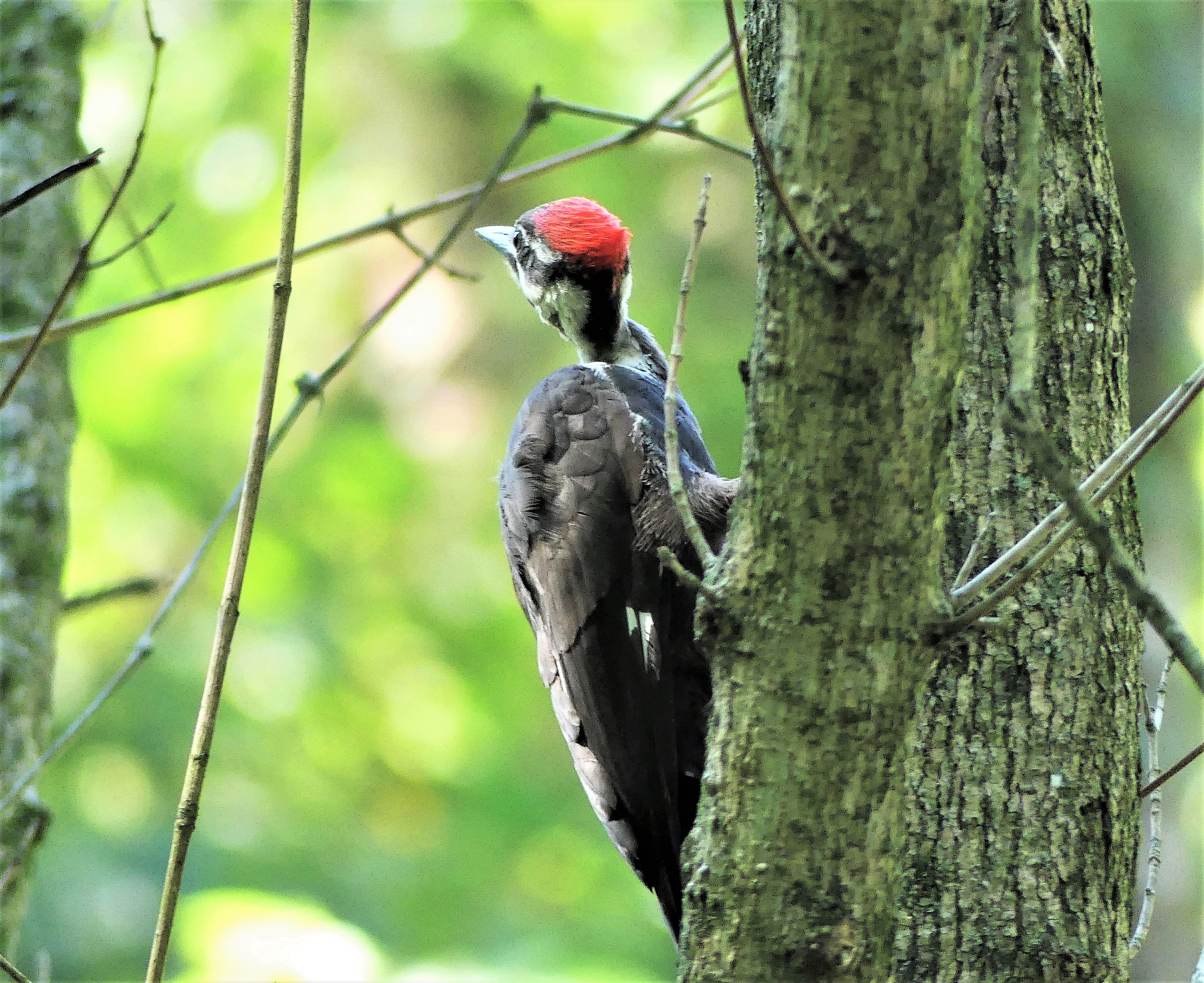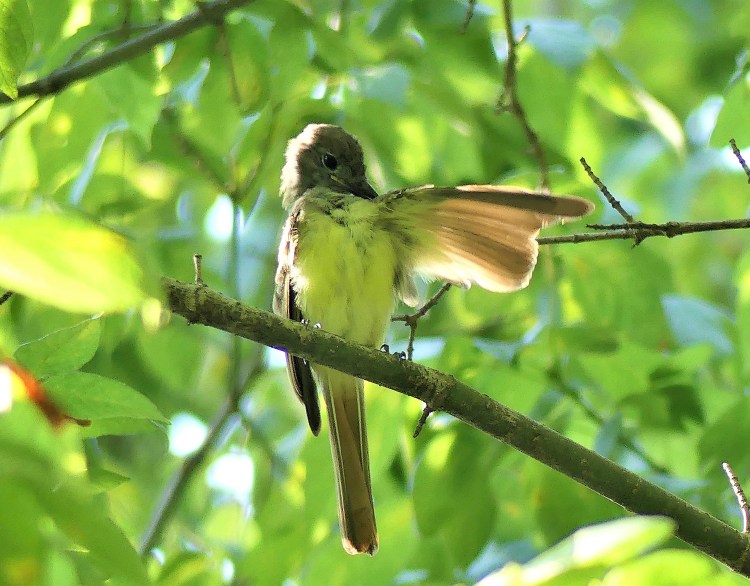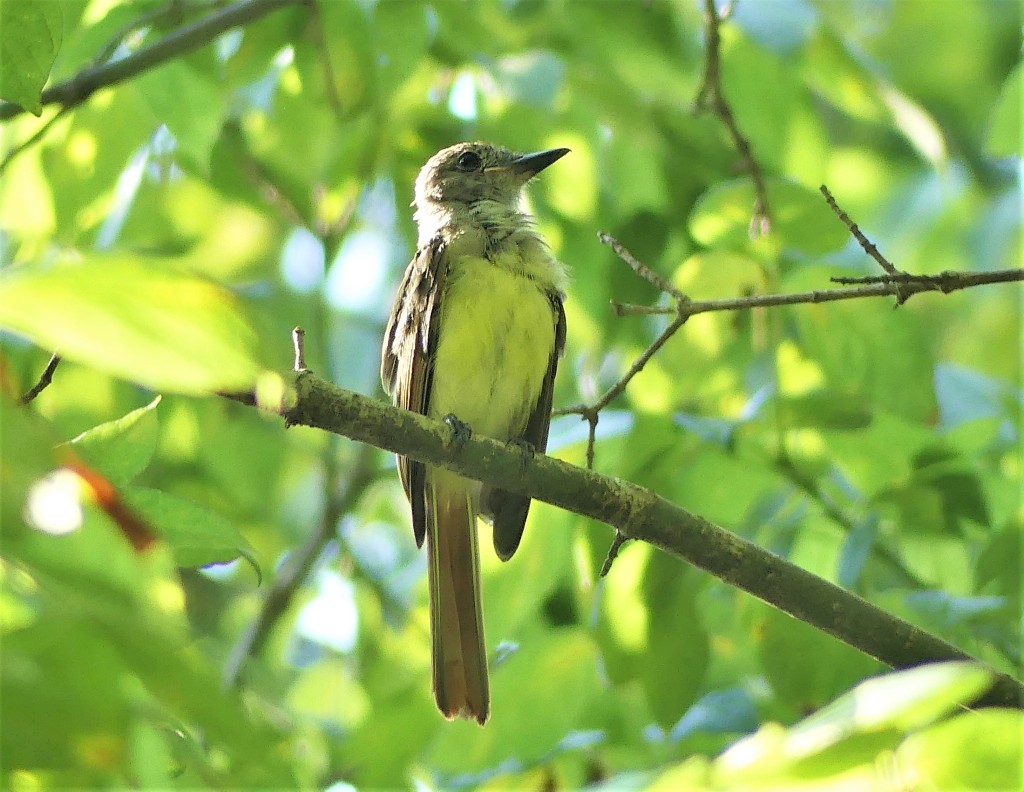
Young birds lucky enough to survive the egg, nestling and fledgling parts of their lives are now juveniles. Though they look a lot like adults, they’re only a few months old at most, and many will soon be facing a long migration south. It’s a precarious life for young birds, needing to learn not only how to find food and escape predators, but also navigate in a world full of of human hazards. (Many window strikes at this time of year are juveniles).

The two young birds in this post are both members of species that are thriving in this little forest. Pileated woodpeckers and Great crested flycatchers are cavity nesters and depend on large trees, particularly declining or dead ones, for nest holes. With so many old ash trees infested with EAB (Emerald ash borer), it’s likely the parents of these two young birds were able to provide high quality nest holes. The flycatcher family may well have nested in a hole previously occupied by woodpeckers, and its parents sought out a snakeskin to adorn the cavity opening (research suggests the purpose is to deter flying squirrels, who eat both eggs and nestlings).


Great crested flycatchers spend much of their lives high in the trees, so I was quite lucky to observe this juvenile doing its daily preening on a low branch. Feather care is an absolutely vital part of bird’s lives, particularly during a molt when small new pinfeathers erupt (I have intimate experience in this area due to living with a number of small parrots, two of whom were sitting on me tending to each others pinfeathers as I wrote this).

Pileated woodpeckers can be easier to observe, since the carpenter ant colonies they seek out are often found in stumps and the lower reaches of declining trees. Such is their unconcern (with humans anyway), I have nearly walked up on them while they were ripping apart rotten logs. The young female in these pics was out learning the ways of woodpeckers near a parent, who called to her every so often.

These young bird’s lives will be quite different in one important way. The woodpecker will stay home, but the flycatcher will soon migrate, traveling alone, to spend its winter in Central America or Mexico. As a neotropical migrant it will be at much higher risk of dangers both natural and human constructed. If it returns to this forest in spring as a breeding adult, it will be a lucky bird indeed.

blissgrey
I wish we did not put so many obstacles in their way.
LikeLiked by 1 person
shoreacres
It’s my dream to see a pileated woodpecker some day. They’re around, particularly in the woods north and northeast of Houston, but it’s going to take more wandering to find them. On the other hand, I know several bloggers who see them on a regular basis — in their back yards! Being willing to let dead and dying trees remain part of their land certainly helps.
LikeLiked by 1 person
oneforestfragment
I am always happy to see them – as one of North America’s three largest woodpecker species, they were the only ones that were not pushed to extinction, and are now even thriving.
LikeLiked by 1 person
tanjabrittonwriter
Thank you for sharing these lovely snapshots. Both species don’t occur in Colorado, but every once in a while a Great-crested drifts off course during migration and is seen here. I have yet to be so lucky.
And speaking of luck–let’s hope these juveniles will encounter much of it on their long and arduous journey. And may they return next spring and have their own offspring in your forest.
LikeLiked by 2 people
oneforestfragment
There are quite a few lovely flycatchers in your state, I recall seeing Scissor-tailed flycatchers on a trip many years ago, but have not seen the Vermillion.
LikeLiked by 1 person
tanjabrittonwriter
Lucky you. A Scissor-tail remains very high on my wish list, but I have been fortunate enough to see Vermilion Flycatchers twice. It depends on where you are in Colorado, but at least in our neck of the woods both are considered rare.
LikeLiked by 1 person
Amy
These pictures take my breath away! I have read other comments, and one person hoping to see a Pileated woodpecker someday. I have seen them through the years, where I live. I will appreciate them, and their young plight, much more now. And that I have seen them! Thank you for this beautiful and educational site.
LikeLiked by 1 person
oneforestfragment
Thankfully the Pileated woodpecker is still with us! Like a number of other forest dependent species, its populations in the east reached a very low ebb in the late 1880’s – early 20th century.
LikeLike